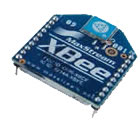
XBee PRO Series 1 - Antenna chip
All prices are VAT included
DIGI part #: XBP24-API-001
The XBee OEM RF module is a ZigBee/IEEE 802.15.4 compliant solution that satisfies the unique needs of low-cost, low-power wireless sensor networks. The modules are easy-to-use, require minimal power and provide reliable delivery of critical data between devices. Its small form factor saves valuable board space. The XBee module operates within the ISM 2.4 GHz frequency band and is pin-for-pin compatible with MaxStream's XBee-PRO (60 mW) Zigbee Module. The modules are optimized for use in US, Canada, Australia, Israel and Europe. No configuration is necessary for out-of-box RF communications. The module?s default configuration supports a wide range of data system applications. Advanced configurations can be implemented using simple AT commands.
Product summary:
- ISM 2.4 GHz operating frequency
- 60 mW (0 dBm) power output (up to 1200m range)
- U.FL. RF Connector, Chip or Whip antenna options
- Industrial (-40 ? 85? C) temperature rating
- Approved for use in the United States, Canada and Europe
- Advanced networking & low-power modes supported
ZigBee is a wireless technology developed as an open global standard to address the unique needs of low-cost, low-power, wireless sensor networks. The standard takes full advantage of the IEEE 802.15.4 physical radio specification and operates in unlicensed bands worldwide at the following frequencies: 2.400?2.484 GHz, 902-928 MHz and 868.0?868.6 MHz. The 802.15.4 specification was developed at the Institute of Electrical and Electronics Engineers (IEEE). The specification is a packet-based radio protocol that meets the needs of low-cost, battery-operated devices. The protocol allows devices to intercommunicate and be powered by batteries that last years instead of hours. The ZigBee protocol carries all the benefits of the 802.15.4 protocol with added networking functionality.
The ZigBee Protocol
The ZigBee protocol was engineered by the ZigBee Alliance , a non-profit consortium of leading semiconductor manufacturers, technology providers, OEMs and end-users worldwide. The protocol was designed to provide OEMs and integrators with an easy-to-use wireless data solution characterized by low-power consumption, support for multiple network structures and secure connections.
The ZigBee Advantage
The ZigBee protocol was designed to carry data through the hostile RF environments that routinely exist in commercial and industrial applications.
ZigBee protocol features:
- Low duty cycle - Provides long battery life
- Low latency
- Support for multiple network topologies: Static, dynamic, star and mesh
- Direct Sequence Spread Spectrum (DSSS)
- Up to 65,000 nodes on a network
- 128-bit AES encryption ? Provides secure connections between devices
- Collision avoidance
- Link quality indication
- Clear channel assessment
- Retries and acknowledgments
- Support for guaranteed time slots and packet freshness
Secure Connections
The ZigBee specification provides a security toolbox approach to ensuring reliable and secure networks. Access control lists, packet freshness timers and 128-bit encryption based on the NIST Certified Advanced Encryption Standard (AES) help protect transmitted data.
ZigBee Applications
ZigBee enables broad-based deployment of wireless networks with low-cost, low-power solutions. It provides the ability to run for years on inexpensive batteries for a host of monitoring applications: Lighting controls, AMR (Automatic Meter Reading), smoke and CO detectors, wireless telemetry, HVAC control, heating control, home security, Environmental controls, drapery and shade controls, etc.
| Standard | ZigBee? 802.15.4 |
Wifi? 802.11b |
Bluetooth? 802.15.1 |
|---|---|---|---|
|
Transmission Range (meters) |
1 ? 100*
|
1 - 100
|
1 ? 10
|
|
Battery Life (days) |
100 ? 1,000
|
0.5 ? 5.0
|
1 - 7
|
|
Network Size (# of nodes) |
> 64,000
|
32
|
7
|
|
Application |
Monitoring & Control
|
Web, Email, Video
|
Cable Replacement
|
|
Stack Size (KB) |
4 ? 32
|
1,000
|
250
|
|
Throughput kb/s) |
20 ? 250
|
11,000
|
720
|
* MaxStream?s XBee-PRO Module yields 2 ? 3x the range of standard ZigBee Modules (up to 1200 meters).
Use Case Scenario
It is 4:00 am on a farm in Iowa. Sensors distributed throughout the fields report the moisture content in the soil and humidity of the air. The staff on the farm uses this data to decide where and when to water for optimum effect. The information also serves as an early warning system for environmental issues such as frost. Precious resources are used more efficiently and productivity increases.
The sensors distributed in the field are interconnected in a ?mesh? network. If a sensor node goes down, the network is self-healing; the nodes are able to connect with one another dynamically, finding another route to stay connected within the network.
Mesh Networks
A key component of the ZigBee protocol is the ability to support mesh networks. In a mesh network, nodes are interconnected with other nodes so that at least two paths connect each node. Connections between nodes are dynamically updated and optimized in difficult conditions. In some cases, a partial mesh network is established with some of the nodes only connected to one other node.
Mesh networks are decentralized in nature; each node is self-routing and able to connect to other nodes as needed. The characteristics of mesh topology and ad-hoc routing provide greater stability in changing conditions or failure at single nodes.
MaxStream XBee & XBee-PRO Modules
MaxStream is a member of the ZigBee Alliance and has developed OEM solutions based on the ZigBee architecture. The XBee and XBee-PRO modules provide an easy-to-implement solution and a powerful boost to range and reliability to companies looking to offer ZigBee
XBee and XBee-PRO features:
- Small form factor
- True plug-and-communicate wireless capability
- Optimized for low cost, low data rate applications
- Long battery life
- Robust security
- High data reliability
- Product interoperability? Modules are interchangeable and pin-for-pin compatible with each other
- XBee-PRO Modules yield 2-3x the range of standard ZigBee Modules (300? ? 1000?)
